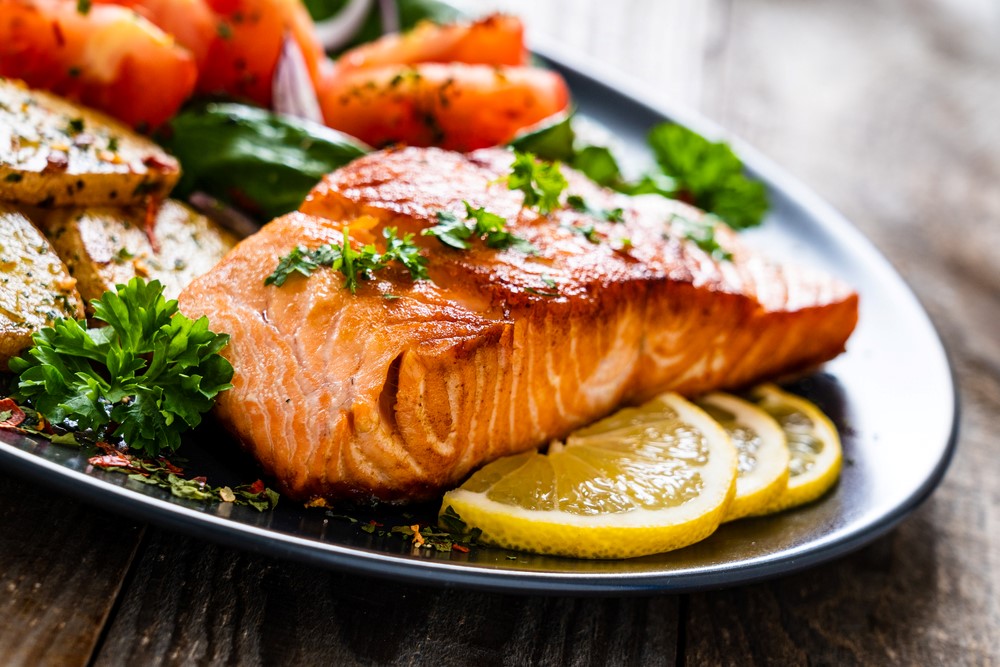
As we age, so does our brain. How we nourish it can make the difference between cognitive decline and potential neurodegenerative disorders or living a mentally sharp healthy life.
Neurodegenerative disorders refer to the many conditions that result from loss of structure and function of the central or peripheral nervous system. The two most common are Parkinson’s and Alzheimer’s disease. In fact, more than 1 in 9 adults aged 65 and above have Alzheimer’s disease, making it the fifth leading cause of death for this age group in the United States.
Besides simply getting older, other factors can increase the risk of these disorders: brain injury, genetics, poorly controlled diabetes, obesity, lack of exercise, and poor diet. These risk factors can lead to hyperglycemia (high blood glucose) and inflammation.
The Importance of Brain Foods for Seniors
You have certainly heard the old saying “You are what you eat” by Brillatt-Savarin. He also coined the saying, “Tell me what you eat, and I will tell you who you are.” He’s right. What you eat impacts your health and longevity. There is no getting around it. To ensure your old age is truly golden, you’ll need to eat differently and eat better, eat more mindfully and with more purpose. And it’s never too late to start.
Some organs age at a much faster rate than others, including our brains. As we age, our brains no longer generate brain cells, called neurons, as quickly as we once did and in most cases these neurons are no longer generated at all.
So how can you change this? How can you slow down your risk of neurodegenerative disorders, halt cognitive decline, or improve your cognition?
Does this mean we should start eating like rabbits and cut out all the foods we know and love? Well, not exactly, but switching to a healthy eating pattern does require some commitment. Your palate may need to get used to new foods, depending on what you grew up with or have eaten up until now.
The Best Brain Foods For Seniors

Brain foods are high in antioxidants, which help fight against inflammation. This is an important effect, as many diseases, from autoimmune conditions to neuro-cognitive disorders are highly prone to inflammation and a pro-inflammatory response, making the condition worse if not managed.
Certain foods have natural anti-inflammatory properties and give the body and brain the fuel it needs to “heal” itself.
1. Pomegranates
I think of this as the fruit of the Greek Gods. Pomegranates are seasonal and encapsulated inside of them are tiny little red rubies full of juice. They are a powerhouse of antioxidants that help fight inflammation. Why are they and their juice so beneficial to brain health? Well, for starters it is one of the few fruits that have been studied and have been part of actual scientific research.
In a study at Loma Linda University, researchers tested pomegranate juice on patients undergoing a certain cardiac procedure that was well known for causing poor memory immediately after the procedure.
They gave some of the patients juice for a few days before the procedure and another group they gave nothing. They found that the group that had the pomegranates and pomegranate juice had no memory loss after their procedure but in fact had increased their mental sharpness.
Loma Linda University has studied this fruit substantially and also sees it as a preventative food for Alzheimer’s disease, particularly due to the polyphenol content.
In an animal study by Hartman and his team, pomegranate juice was linked to a reduction in soluble Abeta 42 accumulation and amyloid deposition in the hippocampus, an effect that could mean decreased risk of Alzheimer’s disease.
Be cautious if you are taking certain medications, as compounds in pomegranate juice and seeds can change the bioavailability of your medication and influence the effects on your body.
In particular, pomegranate may influence blood thinners like warfarin, the type 2 diabetes medication tolbutamide,and also carbamazepine
So, check with your doctor if you plan on drinking more than 4 oz of pomegranate juice per day or taking any supplement.
Uses: Add the arils (seeds) to salads, to garnish any dish like a stuffing, eat on its own mixed with other berries, or enjoy 4 oz of juice in sparkling water for a festive mocktail or in place of red wine. I juice the seeds and add them to a homemade cranberry sauce.
2. Berries
All types, including strawberries, raspberries, blackberries, and blueberries. They are loaded with anti-inflammatory compounds like antioxidants and polyphenols. Berries have similar effects as pomegranates in helping protect neurons from being damaged. Raspberries have neuroprotective polyphenols and have ellagic acid.
Uses: Buy them fresh when in season in your area and opt for organic when you can. Frozen berries are picked and frozen at their prime and offer the same benefits as fresh berries.
Add them to your favorite smoothie recipe, to plain Greek yogurt, add to a fresh green salad for more color and a hint of sweetness, snack on ¾ cup as a midafternoon snack or make them a part of a healthy breakfast when you top your oatmeal with a handful of berries.
3. Dark Chocolate
Yes, chocolate. But not your standard milk chocolate. Health benefits are found in the over 50 compounds found in unadulterated dark chocolate. It is best to buy at least 70% dark or higher. Dark chocolate is a good source of magnesium, iron, phosphorus, zinc, copper, and flavonols.
Flavonols play a role in the production of nitric oxide which helps with blood circulation by relaxing blood vessels and therefore reducing blood pressure and inflammation. This effect can help protect the heart and brain and these flavonols can also help increase insulin sensitivity which can help reduce risk of diabetes. Uncontrolled diabetes is a risk factor for Alzheimer’s disease.
So, opt for ½ to 1 oz of dark 70% or higher chocolate instead of the old sugary sweet milk chocolate.
Make sure to read the ingredients label carefully. Look for products that use few ingredients and little to no added sugar. These will provide the most benefits.
Uses: Melt dark chocolate and dip fresh strawberries, blueberries, or dried apricots for a healthy treat or dessert. Break into pieces and serve with nuts, berries, or other dried fruit. Finely grate one tbsp of dark chocolate and add to frozen yogurt or plain Greek yogurt.
4. Salmon

Salmon is one of the healthiest fish in the sea. It’s very high in omega-3 fatty acids, a good source of fat, a major building block of the brain, and acts as potent anti-inflammatory agents which help protect from inflammation, free radical damage and protects major organs like the heart and neurons, and the brain.
Omega-3’s play a significant role in sharpening memory and protecting the brain from cognitive decline. Salmon is also high in protein which helps build enzymes, hormones, and other essential compounds in the body. Aim to include this in your diet at least 2 times per week. A high-quality fish oil supplement can also be helpful if you don’t like fish at all.
If you have a food allergy to fish or don’t wish to eat fish, then skip this one and find an alternative, such as a plant-based omega-3 supplement, such as flaxseeds or walnuts.
Flaxseeds, chia seeds, and walnuts are very high in ALA, which is a type of omega-3 fatty acid. ALA needs to be converted metabolically to DHA and EPA in the body so that the body can use it. As such, flaxseeds and similar ingredients aren’t as potent as foods already high in DHA and EPA like fish, but they are still a great alternative especially for vegans.
Uses: Opt for fresh wild caught salmon if you can. Bake, grill or pan fry with a touch of olive oil. Canned salmon is also a great option and can be used in place of tuna in a salad.
5. Turmeric
Turmeric is a root spice that is not indigenous to the standard American diet or typical western diet. This spice is a dark yellow in color with a fragrant, earthy, and slightly peppery aroma. The active ingredient in turmeric is curcumin. Research in animals studies and at the cellular level suggest it may have an anti-inflammatory effect and may prevent the build up amyloid beta plaques in the brain, which are a signature marker of many forms of dementia.
There is some promising research in human studies evaluating its potential to improve mental cognition, memory, brain fog, as well as arthritis and joint inflammation. Brain fog is used in the literature to refer to a category of symptoms, such as a lack of focus, poor mental clarity and high mental fatigue. To maximize its bioavailability, it is recommended to add black pepper when using this spice.
Uses: Add turmeric powder or fresh grated root to a vegetable stir fry or curry, add a few teaspoons to savory biscuit dough, drink as a tea with a bit of honey and ginger. Toss cauliflower florets with 1 tablespoon of turmeric powder, ½ teaspoon black pepper, ¼ teaspoon of cumin powder, a dash of salt and olive oil, and roast cauliflower at 400° F for about 30-35 minutes.
6. Green Tea
Green tea is a great alternative to coffee. A naturally caffeinated tea loaded with antioxidants called catechins (a type of flavonoid) which reduce and prevent inflammation that is prevalent in diseases like diabetes, heart diseases, rheumatoid arthritis, neurocognitive conditions like Alzheimer’s and even certain cancers.
Green tea has epigallocatechin-3-gallate (EGCG), a powerful type of catechin.
Uses: Drink 1 to 2 cups per day. Hot or cold. Matcha green tea powder is also versatile and can be added to cookie dough, smoothies or used on its own to make a matcha green tea latte.
7. Dark Leafy Greens
Dark leafy greens include kale, Swiss chard, and spinach. These greens are high in fiber, B vitamins like folic acid, vitamin E and vitamin K, lutein and beta carotene to help reduce inflammation, which is a driving factor in diseases like diabetes, heart diseases, rheumatoid arthritis, neurocognitive conditions like Alzheimer’s and even certain cancers.
Some studies have shown that daily consumption of these dark leafy greens is strongly associated with a slower decline in brain function in the aging brain, therefore, proving their neuroprotective actions.
Check with your medical doctor if you are on any blood thinners (i.e. warfarin; coumadin), as the vitamin K in dark leafy greens can decrease the effectiveness of the medication.
Uses: Wash and dry them and eat them raw in a salad, darker greens with a tougher leaf are excellent for sauteing or adding to a stew or a soup. Blend them into a smoothie with your favorite berries! Remember that all the health benefits of these foods work synergistically so it is best to mix them up and combine them for maximum benefits.
Why Brain Foods Matter So Much Now

Talking about brain foods might sound strange. After all, our parents and grandparents didn’t focus nearly as much on nutrition as we do today. However, diets and lifestyles have changed dramatically since then, and we’ve learned much more about nutrition as well.
Historic Eating Patterns
My in-laws and my own father were born and raised on the standard American traditional diet of the 1940s-1960s. The American diet didn’t have the bad rap it has today.
Everything was cleaner and you knew where you got your milk. Portions were much smaller than today and GMO’s didn’t even exist. Low fat mayo? Didn’t exist. Margarine did not become the fat of choice until the 1970s and 1980s.
But other than that, American meals in my in-laws’ family were a standard western Diet of its time. Very little seasoning was used when cooking. Baked chicken, beef stews, and boiled vegetables, both starchy and non-starchy, always made it to the table. Most meals were made at home and bread was baked fresh from your oven.
As the years went by, things changed and so did our knowledge about nutrition and our food supply. We learned that we couldn’t trust our government to regulate our food chain supply and food manufacturers outsmarted policy at every step. Clever marketing steered us toward unhealthy choices.
Fast forward to the 1980s, Americans began eating more fast food, more processed and convenience foods including TV dinners, frozen meals, packaged snacks, and foods loaded with preservatives, sodium, sugar, saturated fat, artificial flavors, artificial colors, antifungals (yes!), flavor enhancers, artificial flavors, and many more chemicals than ever before.
Between the 1990s to 2000s, we were in full swing of a global obesity epidemic with autoimmune diseases on the rise. And the truth is that this type of eating pattern is killing us and deteriorating our health and our brains are suffering because of it.
Modern Diets
A typical western diet, which many health experts refer to as the “SAD” (Standard American Diet) diet is made up mostly of foods with a high calorie density and fat percentage, and low nutritional value.
It is this SAD eating pattern that research has proven to be one of the culprits behind inflammation and inflammation-related diseases. To be fair, these effects are not 100% diet-related. Genetics and other lifestyle and environmental factors do play a role.
Diet, however, is the one thing that we can control and that has very long-lasting effects, along with getting active. The food we eat can have medicinal and healing effects or can have the complete opposite.
Shifting away from the typical SAD eating pattern and focusing on brain foods for seniors won’t suddenly cure you of disease, but focusing on healthy foods consistently should keep you healthier and lower the risk of health problems, including cognitive impairment.
Who knows, you might even live longer?
How to Take Advantage of Brain Foods

Many foods work synergistically. This means that no single food can provide you with everything you need. Even these popular “superfoods” will not work on their own. They need other foods and the ingredients or properties from those foods to work their magic.
We know this as a fact in basic nutrition. A basic example is, vitamin C can help increase the bioavailability of iron rich foods when taken together. The same goes for these superfoods and brain foods for seniors.
It is best to have a balanced diet filled with vegetables and fruits from all colors of the rainbow.
If you are adamant about increasing your fruit and vegetable intake and you feel resistant to change, then take it slow. One step at a time is best.
Reduce Your Focus on Processed Foods
A preliminary step to better brain health would be to substantially reduce all or most processed products from your home. This includes store-bought prepackaged baked goods, (ex. cookies and baked goods with a very long shelf life), chips, microwave popcorn, packaged snacks, most boxed morning cereals, instant soups, canned soups, canned pasta, certain canned meats, and packaged seasoning kits.
As you can see, these items are mostly found in the middle or center of any typical large grocery store.
It is recommended to try and do most of your shopping from items at the perimeter of the store. What foods are found there? Fresh bakery goods with a very short shelf life, fresh fruits and vegetables, meats, poultry, fish, dairy, and eggs section.
You may want to skip the alcoholic drink section if it happens to be on the perimeter of the store.
Increase Your Intake of Whole Foods
Next, you’ll want to replace those unwanted items and begin incorporating 7 of my top brain foods for seniors, along with other unprocessed foods, including fresh vegetables, fruits, legumes, and whole grains.
These foods are packed with fiber, antioxidants and anti-inflammatory factors, disease-fighting polyphenols, essential nutrients such as vitamins A, D, C and much-needed minerals for nerve, bone, and muscle support, omega-3 fatty acids, and protein.
Use Healthy Recipes and Meal Plans
Remember, not one of these foods on their own can promise effective results. It is best to eat them paired together daily because their properties work best synergistically.
For more ideas about how to use all of these healthy ingredients, including the brain foods for seniors that were featured earlier, try turning to healthy cookbooks and recipes. We have many lists of recipes to get you started, including vegetarian recipes, an anti-inflammatory Indian diet plan, and soft foods for seniors.
Here are a few of our favorite cookbooks as well, which all feature healthy ingredients and meals that you’re certain to love:
- The Heart Healthy Cookbook for Two
- The Well Plated Cookbook
- The Complete Clean Eating Cookbook
- 5-Ingredient Clean Eating Cookbook

Vanessa Aldaz, MPH RDN CDCES
Registered dietitian nutritionist and founder of the Better Brain Way Plan, Vanessa received her MPH in Nutrition from Loma Linda University in 2004 and has a B.S. in Biochemistry and Cell Biology from the University of California San Diego.
She has specialized in ketogenic diet therapies for epilepsy and neurological disorders for the past 18 years in the clinical setting working with patients of all ages including infants. She has now dedicated her passion and expertise for brain health and nutrition by helping women improve their brain health and regain their energy and confidence through nutrition and mindfulness techniques.
Follow Vanessa on IG @vanessa.a.nutrition
Facebook business page: @thegoodbrainRD
Read her free guide here


Leave a Reply